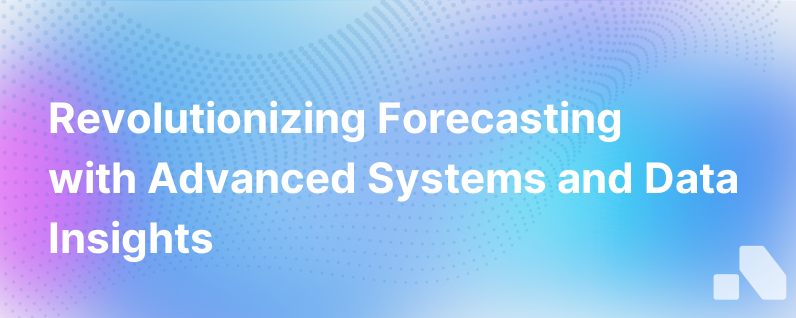
The world of sales is driven by forecasts; they are the rudders that guide businesses towards future profitability and sustainability. However, traditional forecasting methods often prove inaccurate, leaving companies adrift in tumultuous economic seas. In recent years, as forecasting has become even more central to business operations, organizations have been compelled to look towards better systems and better data to chart more reliable courses.
What does the future of forecasting hold for us, and how will better systems interplay with more refined data to revolutionize our predictive capabilities?
Embracing Advanced Technologies in Forecasting
The future of forecasting lies in the marriage of technology and analytics. Artificial intelligence (AI) and machine learning (ML) have begun to transform forecasting methods from educated guesses to data-driven predictions. These advanced technologies can process vast datasets quickly, detect patterns, learn from outcomes, and continuously improve over time.
Using predictive analytics, AI systems can forecast demand, optimize stock levels, and even anticipate market changes with remarkable acuity. These technologies imbue systems with the ability to not only analyze historical data but also incorporate real-time data streams—from economic indicators to social media trends—ensuring that forecasts are both current and relevant.
Integration with the Internet of Things (IoT)
IoT devices provide real-time data that enhance forecasting systems. Sensors and smart devices track everything from warehouse inventory levels to customer buying habits, feeding data back into AI algorithms. This mesh of interconnected devices creates an ecosystem of continuously updated information that can be leveraged to create more responsive and dynamic forecasts.
In a connected IoT world, a dip in raw material quality can be instantly factored into production yield forecasts, or a change in weather patterns can update shipping logistics and demand predictions.
Cloud Computing: Enhancing Accessibility and Scalability
Cloud-based forecasting solutions offer flexibility and scalability to businesses. Leveraging cloud computing ensures that businesses of all sizes have access to powerful forecasting tools without massive upfront investments in infrastructure. Startups and small businesses can harness the power of sophisticated forecasting methods previously available only to large enterprises.
Cloud services also facilitate the integration of disparate data sources, breaking down silos and providing a holistic view of the data necessary for accurate forecasting.
The Role of Big Data
The adage “garbage in, garbage out” is particularly pertinent to forecasting. The quality and breadth of data inputted into forecasting models are integral to the reliability of the output. Big Data technologies have expanded the capacity of businesses to capture, store, and manage enormous amounts of data from various sources, leading to richer insights.
Furthermore, advancements in data analytics methodologies enable the effective segregation of noise from useful data, allowing systems to focus on the most predictive indicators.
Collaboration and Democratization of Forecasting
Traditional forecasting often occurs within the confines of specialized departments, limiting the scope of input and perspective. The future points toward democratized forecasting, where cross-departmental collaboration is facilitated by easy-to-use platforms. This approach marries domain expertise with predictive models to yield a more accurate picture of the future.
By enabling various stakeholders to input and receive pertinent forecasting information, organizations create a feedback loop that refines the accuracy of predictive models.
Prescriptive Analytics, the Next Frontier
While predictive analytics can forecast the likelihood of future events, prescriptive analytics takes it a step further by offering actionable recommendations. The integration of prescriptive analytics into forecasting systems is poised to not only predict the future but also to recommend strategies that can positively influence outcomes.
Imagine a sales forecasting system that not only predicts a sales slump but also suggests a targeted promotion to bolster revenue. As AI systems become more sophisticated, this level of prescription will become increasingly nuanced and effective.
The Human Element: Decision Science
Despite the leaps in technology, the human element remains a crucial part of forecasting. Decision sciences, which integrate psychological insights into the forecasting process, help to interpret and act on the predictions made by AI systems. The marriage of machine precision and human intuition creates a formidable combination for decision-making.
In the future, training in decision sciences will likely become an integral part of the skill set for those in roles that rely heavily on forecasting.
Real-Time Forecasting
In the fast-paced business environment, static forecasting is becoming less useful. Real-time forecasting, updated instantly as new data comes in, will become the new standard. This approach will help companies stay agile, make quick adjustments, and take advantage of emerging opportunities more readily than ever before.
Conclusion
Forecasting is undergoing a metamorphosis, driven by technological advancements and a deeper reliance on data insights. The synergetic relationship between superior data collection methods, AI, ML, IoT, and human expertise is crafting a future where business forecasting is more accurate, actionable, and indispensable.
As we move forward, it is crucial for organizations to invest in these technologies to not merely predict future trends but also to actively shape them. The future of forecasting is not about passively looking into a crystal ball; it is about making data-driven decisions in real-time, guided by systems that learn and adapt at the speed of business.
For companies that wish to remain competitive, implementing better forecasting systems with better data isn't just an aspiration—it's an imperative. Solutions like Aomni bridge the gap between the wealth of data available and the need for accurate, real-time insight, equipping businesses to navigate the future with confidence.